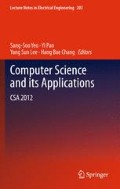Abstract
In this paper, we propose a new bimodal cryptographic algorithm BAT. BAT provides a hash function BAT-H and a block cipher BAT-B. Moreover, according to some parameters, it is possible to combine BAT-H and BAT-B to one integrated module. Thus, the algorithm is suitable for various environments, such as RFID and USN, where a hash function and a block cipher are required simultaneously. From our implementation results, our integrated module is more efficient than the case of the combination of known dedicated hash functions and block ciphers.
Access this chapter
Tax calculation will be finalised at checkout
Purchases are for personal use only
References
Bogdanov, A., Knudsen, L., Leander, G., Paar, C., Poschmann, A., Robshaw, M., Seurin, Y., Vikkelsoe, C.: PRESENT: An ultra-lightweight block cipher. In: Paillier, P., Verbauwhede, I. (eds.) CHES 2007, LNCS, vol. 4727, pp. 450–466. Springer, Berlin (2007)
Guo, J., Peyrin, T., Poschmann, A., Robshaw, M.: The LED block cipher. In: Preneel, B., Takagi, T. (eds.) CHES 2011, LNCS, vol. 6917, pp. 326–341. Springer, Berlin (2011)
Hong, D., Sung, J., Hong, S., Lim, J., Lee, S., Koo, B., Lee, C., Chang, D., Lee, J., Jeong, K., Kim, H., Kim, J., Chee, S.: HIGHT: A new block cipher suitable for low-resource device. In: Goubin, L., Matsui, M. (eds.) CHES 2006, LNCS, vol. 4249, pp. 46–59. Springer, Berlin (2006)
Shibutani, K., Isobe, T., Hiwatari, H., Mitsuda, A., Akishita, T., Shirai, T.: Picollo: An ultra-lightweight blockcipher. In: Preneel, B., Takagi, T. (eds.) CHES 2011, LNCS, vol. 6917, pp. 342–357. Springer, Berlin (2011)
Aumasson, J., Henzen, L., Meier, W., Naya-Plasencia, M.: Quark: A lightweight hash. In: Mangard, S., Standaert, F.-X. (eds.) CHES 2010, LNCS, vol. 6225, pp. 1–15. Springer, Berlin (2010)
Bogdanov, A., Leander, G., Paar, C., Poschmann, A., Robshaw, M., Seurin, Y.: Hash functions and RFID tags: Mind the gap. In: Oswald, E., Rohatgi, P. (eds.) CHES 2008, LNCS, vol. 5154, pp. 283–299. Springer, Berlin (2008)
Bogdanov, A., Knežević, M., Leander, G., Toz, D., Varıcı, K., Verbauwhede, I.: SPONGENT: A lightweight hash function. In: Preneel, B., Takagi, T. (eds.) CHES 2011, LNCS, vol. 6917, pp. 312–325. Springer, Berlin (2011)
Guo, J., Peyrin, T., Poschmann, A.: The PHOTON family of lightweight hash functions. In: Rogaway, P. (ed.) Crypto 2011, LNCS, vol. 6841, pp. 222–239. Springer, Berlin (2011)
Badel, S., Dagtekin, N., Nakahara, J., Ouafi, K., Reffe, N., Sepehrdad, P., Susil, P., Vaudenay, S.: ARMADILLO: A Multi-purpose cryptographic primitive dedicated to hardware. In: Mangard, S., Standaert, F.-X. (eds.) CHES 2010, LNCS, vol. 6225, pp. 398–412. Springer, Berlin (2010)
Aoki, K., Ichikawa, T., Kanda, M., Matsui, M., Moriai, S., Nakajima, J., Tokita, T.: Camellia: A 128-bit block cipher suitable multiple platforms—design and analysis. In: Stinson, D. R., Tavares, S. (eds.) SAC 2000, LNCS, vol. 2012, pp. 39–56. Springer, Berlin (2000)
Bertoni, G., Daemen, J., Peeters, M., Assche, G.: On the indifferentiability of the sponge construction. In: Smart, N. (ed.) EUROCRYPT 2008, LNCS, vol. 4965, pp. 181–197. Springer, Berlin (2008)
Bertoni, G., Daemen, J., Peeters, M., Assche, G.: Sponge-based pseudo-random number generators. In: Mangard, S., Standaert, F.-X. (eds.) CHES 2010, LNCS, vol. 6225, pp. 33–47. Springer, Berlin (2010)
Bertoni, G., Daemen, J., Peeters, M., Assche, G.: Cryptographic sponge functions. Available at http://sponge.noekeon.org/CSF-0.1.pdf. (2011)
Gorski, M., Lucks, S., Peyrin, T.: Slide attacks on a class of hash functions. In: Pieprzyk, J. (ed.) ASIACRYPT 2008, LNCS, vol. 5350, pp. 143–160. Springer, Berlin (2008)
Khovratovich, D., Nikolic, I., Rechberger, C.: Rotational rebound attacks on reduced skein. In: Abe, M. (ed.) ASIACRYPT 2010, LNCS, vol. 6477, pp. 1–19. Springer, Berlin (2010)
Sasaki, Y., Yasuda, K.: Known-key distinguishers on 11-round feistel and collision attacks on its hashing modes. In: Joux, A. (ed.) FSE 2011, LNCS, vol. 6733, pp. 397–415. Springer, Berlin (2011)
Feldhofer, M., Rechberger, C.: A case against currently used hash functions in RFID protocols. In: Meersman, R., Tari, Z., Herrero, P. (eds.) OTM 2006, LNCS, vol. 4277, pp. 372–381. Springer, Berlin (2006)
Kim, M., Ryou, J., Jun, S.: Efficient hardware architecture of SHA-256 algorithm for trusted mobile computing. In: Yung, M., Liu, P., Lin, D. (eds.) Inscrypt 2008, LNCS, vol. 5487, pp. 240–252. Springer, Berlin (2009)
Henzen, L., Aumasson, J., Meier, W., Phan, R.: LSI characterization of the cryptographic hash function BLAKE. Available at http://131002.net/data/papers/HAMP10.pdf. (2010)
Tillich, S., Feldhofer, M., Issovits, W., Kern, T., Kureck, H., Mhlberghuber, M., Neubauer, G., Reiter, A., Kofler, A., Mayrhofer, M.: Compact hardware implementations of the SHA-3 candidates ARIRANG, BLAKE, Gröstl, and Skein. Cryptology ePrint Archive, Report 2009/349. Available at http://eprint.iacr.org/2009/349. (2009)
Lee, Y., Chan, H., Verbauwhede, I.: Iteration Bound Analysis and Throughput Optimum Architecture of SHA-256 (384, 512) for Hardware Implementations, WISA 2007, LNCS, vol. 4867, pp. 102–114. Springer, Berlin (2007)
Gong, Z., Nikova, S., Law, Y.-W.: KLEIN: A new family of lightweight block ciphers. In: Juels, A., Paar, C. (eds.) RFIDSec 2011, LNCS, vol. 7055, pp. 1–18. Springer, Berlin (2012)
Moradi, A., Poschmann, A., Ling, S., Paar, C., Wang, H.: Pushing the limits: A very compact and a threshold implementation of AES. In: Paterson, K. G. (ed.) EUROCRYPT 2011, LNCS, vol. 6632, pp. 69–88. Springer, Berlin (2011)
Acknowledgments
This work was supported the IT R&D program of MKE, Korea [Development of Privacy Enhancing Cryptography on Ubiquitous Computing Environment].
Author information
Authors and Affiliations
Corresponding author
Editor information
Editors and Affiliations
Appendix: Figure
Appendix: Figure
Rights and permissions
Copyright information
© 2012 Springer Science+Business Media Dordrecht
About this paper
Cite this paper
Lee, J. et al. (2012). BAT: Bimodal Cryptographic Algorithm Suitable for Various Environments. In: Yeo, SS., Pan, Y., Lee, Y., Chang, H. (eds) Computer Science and its Applications. Lecture Notes in Electrical Engineering, vol 203. Springer, Dordrecht. https://doi.org/10.1007/978-94-007-5699-1_37
Download citation
DOI: https://doi.org/10.1007/978-94-007-5699-1_37
Published:
Publisher Name: Springer, Dordrecht
Print ISBN: 978-94-007-5698-4
Online ISBN: 978-94-007-5699-1
eBook Packages: Computer ScienceComputer Science (R0)

